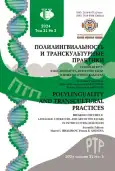Comparative Analysis of the Functioning of Prepositions / Postpositions and Conjunctions as Means of Expressing the Category of Precedence in the Tatar and Russian Languages
- 作者: Lutfullina G.F.1
-
隶属关系:
- Kazan State Energy University
- 期: 卷 21, 编号 3 (2024): BREAKING THE CIRCLE: LANGUAGE, LITERATURE, AND ART OF THE TATARS IN INTERCULTURAL DIALOGUES
- 页面: 408-427
- 栏目: Language in System
- URL: https://journal-vniispk.ru/2618-897X/article/view/326907
- DOI: https://doi.org/10.22363/2618-897X-2024-21-3-408-427
- EDN: https://elibrary.ru/UPDHMD
- ID: 326907
如何引用文章
全文:
详细
This article presents a semantic-syntactic analysis of prepositions / postpositions and conjunctions of the Tatar and Russian languages with the semantics of precedence. The purpose of the study is to determine the peculiarities of the functioning of prepositions/postpositions and conjunctions of differently structured languages involved in the representation of the category of precedence. The work defines a range of prepositions and conjunctions of temporal semantics that realize the meaning under study. The scientific novelty is that the dominant functions of preposition/postposition or conjunction have been identified as non-verbal means of expressing temporality, in particular, the meaning of precedence, in determining the temporal meaning of a statement. The results obtained showed that in both languages the potential of representation by prepositions / postpositions and precedent conjunctions is determined by their compatibility. In both languages, postpositions / prepositions and postpositional words are characterized by high frequency functioning. In both languages, there is a preference for expressing precedence towards the evening time of day, which is logically understandable. The Tatar language also contains postpositional words. The semantics of precedence in time correlates with the semantics of precedence in space, the third additional meaning is proportionality, comparison in size. In the Russian language, prepositions are polysemantic and have an extremely high frequency of functioning, that is, the semantics of precedence is only one of the meanings. They often realize the meaning of the degree of manifestation and many others. In both languages, the semantics of precedence in complex sentences is realized by conjunctive expressions, including postpositions and prepositions of the same semantics. In the Tatar language there are subordinate and welded clauses, but in the Russian language only subordinate clauses are presented.
作者简介
Gulnara Lutfullina
Kazan State Energy University
编辑信件的主要联系方式.
Email: Gflutfullina@mail.ru
ORCID iD: 0000-0003-1572-5314
SPIN 代码: 9879-1962
Scopus 作者 ID: 5611463120
Researcher ID: O-8604-2015
Professor, Doctor of Philology, Head of the Department of Foreign Languages
51 St. Krasnoselskaya, Kazan, 420066, Russian Federation参考
- Saifulina, F.S., and L.I. Mingazova. 2023. “Strategies for translating Tatar literature into Turkic languages: history and current state.” Polylinguality and Transcultural practices, vol. 20, no. 4, pp. 659–672. https://doi.org/10.22363/2618-897X-2023-20-4-659-672
- Kuznetsov, M.Yu. 2023. “Determining the stem of a Tatar verb by its infinitive.” Polylinguality and Transcultural practices, vol. 20, no. 2, pp. 249–260. https://doi.org/10.22363/2618-897X2023-20-2-249-260
- Zaripova, I.F. 2009. “The role of postpositions in the system of subordinating connections of words in the Tatar language.” Bulletin of the Bashkir University, vol. 14, no. 4., pp. 14–17. Print. (In Russ.)
- Tatar grammar. In 2 vols. 1998. Vol. 2. Kazan: Matburag Yorty publ. Print. (In Tatar).
- Khasanova, M.S. 2013. “Taxis of following in the Russian and Tatar languages: functionalsemantic correspondences.” Bulletin of the Chelyabinsk State University, vol. 301, no. 10. Philology. Art history, issue 76, pp. 96–100. Print. (In Russ.)
- Khasanova, M.S. 2010. “Means of expressing independent taxis of succession in differently structured languages (based on the Russian and Tatar languages).” Bulletin of the Bashkir University, vol. 11, no. 3, pp. 123–126. Print. (In Russ.)
- Sai, S.S. 2010. “Dynamics of development of time circumstances with the meaning of precedence by interval in the Russian language.” In Redundancy in the grammatical structure of the language [Acta Linguistica Petropolitana. Proceedings of the Institute of Linguistic Research of the Russian Academy of Sciences, vol. VI, part 2]. Edited by M.D. Voeykova. St. Petersburg: Nauka publ., pp. 131–183. Print. (In Russ.)
- Rakhmatullina, D.E. 2009. “Referential features of English prepositions with phrasal verbs in statements with semantics of temporal sequence.” Bulletin of UNN, vol. 2, no. 6, pp. 333–337. Print. (In Russ.)
- Lutfullina, G.F. 2011. “Comparative study of the category of quantification-deterministic polysituationalism in unrelated languages (based on the French and Tatar languages).” Dis. Dr. Philol. Sciences. Kazan. Print. (In Russ.)
- Karimova, D.E. 2022. “Expression of the relation of precedence in complex sentences with the subordinate part of time in the Russian language (based on the material of literary works of Russian writers).” Science and innovation, vol. 1, no. 7. Print. (In Russ.)
- Karimov, N.A. 2020. “Ways to connect a sentence in complex sentences with subordinate tenses in the Russian language (based on stories and Russian stories by I.A. Kuprin).” Bulletin of the Pedagogical University, no. 7, pp. 45–55. Print. (In Russ.)
- Giniyatullina, L.M. 2022. “The function of conjunctions in a complex syntactic whole in the Tatar language.” Philological Sciences. Questions of theory and practice, vol. 15, issue 5, pp. 1434–1438. Print. (In Russ.)
补充文件









